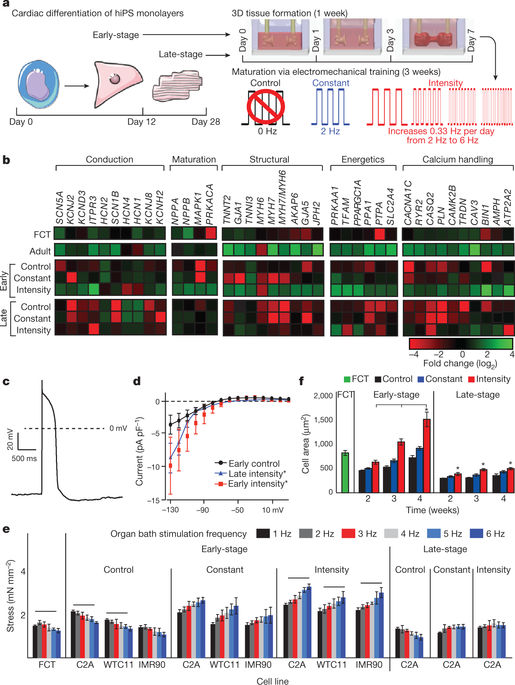Advanced maturation of human cardiac tissue grown from pluripotent stem cells
Kacey Ronaldson-Bouchard, Stephen P. Ma, Keith Yeager, Timothy Chen, LouJin Song, Dario Sirabella, Kumi Morikawa, Diogo Teles, Masayuki Yazawa, Gordana Vunjak-Novakovic
文献索引:10.1038/s41586-018-0016-3
全文:HTML全文
摘要

Cardiac tissues generated from human induced pluripotent stem cells (iPSCs) can serve as platforms for patient-specific studies of physiology and disease1,2,3,4,5,6. However, the predictive power of these models is presently limited by the immature state of the cells1, 2, 5, 6. Here we show that this fundamental limitation can be overcome if cardiac tissues are formed from early-stage iPSC-derived cardiomyocytes soon after the initiation of spontaneous contractions and are subjected to physical conditioning with increasing intensity over time. After only four weeks of culture, for all iPSC lines studied, such tissues displayed adult-like gene expression profiles, remarkably organized ultrastructure, physiological sarcomere length (2.2 µm) and density of mitochondria (30%), the presence of transverse tubules, oxidative metabolism, a positive force–frequency relationship and functional calcium handling. Electromechanical properties developed more slowly and did not achieve the stage of maturity seen in adult human myocardium. Tissue maturity was necessary for achieving physiological responses to isoproterenol and recapitulating pathological hypertrophy, supporting the utility of this tissue model for studies of cardiac development and disease.
|
Vms1 and ANKZF1 peptidyl-tRNA hydrolases release nascent cha...
2018-04-09 [10.1038/s41586-018-0022-5] |
|
Fatal swine acute diarrhoea syndrome caused by an HKU2-relat...
2018-04-04 [10.1038/s41586-018-0010-9] |
|
Crystal structures of the gastric proton pump
2018-04-04 [10.1038/s41586-018-0003-8] |
|
The evolutionary history of vertebrate RNA viruses
2018-04-04 [10.1038/s41586-018-0012-7] |
|
Accelerated increase in plant species richness on mountain s...
2018-04-04 [10.1038/s41586-018-0005-6] |